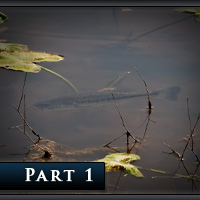
The Definitive Guide to Bed Fishing – Part I
Published April 12, 2010 by Kevin ScarselliIf you are looking to take your bed fishing skills to new heights, this guide will be of immense value to you.
You will discover the little-known tactics and shortcuts for not only spotting bass and beds, but the techniques for getting bed fish to bite.
Let’s begin…
Part 1: How To Find Spawning Bass
Where To Find Bass On Beds (It’s Easy!)
Finding beds is easy. Don’t let anyone tell you it is difficult or that you need a higher-level of knowledge to find them.
With a bit of “run and gun” exploration, you will find beds mostly in:
- Protected coves, bays and creeks
- Around shallow-ends of docks
- Shallow flats that are protected from strong current or wind
There are also three main-ingredients for finding lots of beds:
- Protection from wind, waves and current
- Shallow water
- “Harder” bottoms
While bass will spawn all over the lake, the majority of bass will seek out “prime” spawning areas that exhibit the three aforementioned ingredients. These areas will have much higher concentrations of beds, making your fishing immensely more productive.
1. Protection From The Elements
Good spawning habitat is well-protected from the elements.
Eggs laid in areas with strong current are prone to being silted over. Same with areas that aren’t protected from strong winds or waves. The eggs can fall victim to many such disturbances.
Fish know this. So they choose areas away from the main lake. They like protected coves, bays and creeks.
Look at a map and start choosing such spots that show protection from the elements.
2. Shallow Water
One requirement for the hatching of eggs is ample sunlight. So know that most bass like to bed shallow where sunlight can reach the nest.
Bass will always bed shallower in muddy water, and can bed substantially deeper in clear water.
In the clearest of lakes and reservoirs, you may find beds and bass as deep as 15 feet.
In stained water with clarity of 1-2 feet, they will generally bed at depths of 0-4 feet deep.
These are just generalizations but are very realistic nonetheless.
Your bed searching should, in most lakes, be focused in 0-5 feet of water.
3. “Harder” Bottoms
Bass very much prefer to build nests on hard bottoms.
Why?
Because soft bottoms, like mud, will silt over the eggs, destroying them.
So understand that you should focus on areas that have “harder” bottoms. Good bottoms for spawning are…
- Sandy bottoms
- Gravel (ie. Pea Gravel or Chunk Rock)
Depending on the lake you’re fishing, these types of bottoms may be very limited. Some ponds or lakes may not even have gravel or sand bottoms. In this case, you need to find “harder” bottoms.
If your lake has mud or clay banks, you need to find the “hardest” mud or clay banks.
How To Determine Hardness of Bottom
The quickest way to determine if the bottom is “harder” is with your rod tip. Just put it under water and press it into the lake floor. You can also use your sonar’s color or grayscale. But using your rod is faster and easier in such shallow water.
When To Start Looking For Beds
As a general rule, you can begin looking for bass on beds when water temps are in the upper-50’s, all the way to 70-degrees. The prime water temps for spawning is low to mid-60’s.
Water Temp Is Less Important Than Moon Phase
When it comes to the spawn, moon phase is everything.
The strongest spawning periods occur during full or new moons (a new moon is when the moon is not visible at all).
So if water temps hit 60 degrees and it’s a half moon, bass may not start bedding heavily quite yet.
But if water temps hit 60 degrees and it’s a full moon, you’ll have a lot more bedding activity going on.
So keep a close eye on the moon phase calendar and you’ll be better able to predict when the prime beginning and end periods of the spawn are.
North End of Lakes Start First, South End Finishes Last
Because the sun is more in the Southern hemisphere during the winter and spring, the Northern part of lakes receive more sunlight and is generally a few degrees warmer than the South part of the lake.
Because of this, the spawn will begin earlier on the Northern part of the lake. So if you don’t see many beds on the South side of the Lake, there might be a chance there are plenty of beds on the Northern side.
When most of the bass on the Northern part of the lake are spawned out, you can usually start fishing the South side of the lake and find more beds. The South side’s spawn is generally behind the Northern since it is a few degrees cooler.
Partial Sunlight: Key Ingredient To A Good Nest Location
Bass generally will not build a nest in spots that receive little to no sunlight.
Largemouth love to build nests around docks, but generally will not build them in areas underneath the dock that are in heavy or complete shade.
Beds need “partial sunlight” for proper incubation.
This does not mean bass can’t spawn in the shade. They can and will. But it won’t be DARK shade.
Knowing this lets you eliminate a lot of water around docks and will help you focus your attention on areas that receive partial or complete sunlight.
In Part 2 of The Definitive Guide to Bed Fishing, you will discover the little-known tricks for seeing underwater with your eyes.
- Part 1: Where To Find Beds
- Part 2: Tricks For Seeing Underwater
- Part 3: What To Look For When Scanning For Bass and Beds
- Part 4: Tactics For Catching Bedding Bass








